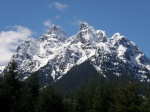Collected Coast Oak
+2
bumblebee
mike page
6 posters
Page 1 of 1
 Collected Coast Oak
Collected Coast Oak
Coast oak (quercus agrifolia) I collected many years ago. Height from pot rim is 32 inches.
The pot was especially made for this tree by Dale Cochoy.
I've been doing some trimming to start the process of getting it show ready by late spring. Sometime in Feburary or early March when the new leaf buds start to swell, I will start a partial defoliation of the old leaves and feeding to promote new shoots and foliage.
Mike

The pot was especially made for this tree by Dale Cochoy.
I've been doing some trimming to start the process of getting it show ready by late spring. Sometime in Feburary or early March when the new leaf buds start to swell, I will start a partial defoliation of the old leaves and feeding to promote new shoots and foliage.
Mike


mike page- Member
 Collected Coast Oak
Collected Coast Oak
Love the tree Mike. How about changing the planting angle, with a 30 degree lean to the left?
Guest- Guest
 Re: Collected Coast Oak
Re: Collected Coast Oak
Mike,
I'm interested in the base of this tree. Can you talk about that part of the structure? Thanks.
Libby
I'm interested in the base of this tree. Can you talk about that part of the structure? Thanks.
Libby
bumblebee- Member
 Re: Collected Coast Oak
Re: Collected Coast Oak
Many of the coast live oak bonsai I have seen have a bulbous base. I have yet to find any information on it, possibly because they are not a really popular tree for bonsai (under-rated!) My own theory, since they come from dry climates, is that when the tap root is cut, they do this in order to store more water. Coming from their native area in CA I never saw one in nature with that base. Here's mine, tap root cut 16 years ago:bumblebee wrote:Mike,
I'm interested in the base of this tree. Can you talk about that part of the structure? Thanks.
Libby


bisjoe- Member
 Re: Collected Coast Oak
Re: Collected Coast Oak
There are many different types of Oak and many of them show this type of swelling, drought tollerant or not. I think it's no more than a feature of the species.
Guest- Guest
 e: Collected Coast Oak
e: Collected Coast Oak
Hi Mike. I prefer the 30 degree angle, as the head of foliage is over the root and the branches are less flat from side to side. I would'nt hide the bole either, as it's a natural feature of the species.
Guest- Guest
 Re: Collected Coast Oak
Re: Collected Coast Oak
lovely tree
i like the 30 degree change and make a feature of the shari
the photos make the shari look a bit bleached and featureless
have a look at some natural hollows in oaks and i am sure the tree will look better for it
regards
steve
i like the 30 degree change and make a feature of the shari
the photos make the shari look a bit bleached and featureless
have a look at some natural hollows in oaks and i am sure the tree will look better for it
regards
steve

bigsteve- Member
 Re: Collected Coast Oak
Re: Collected Coast Oak
bumblebee wrote:Mike,
I'm interested in the base of this tree. Can you talk about that part of the structure? Thanks.
Libby
I just did some reading on the flora of California chaparral. The book mentions that many of the California native plants develop a subterranean basal burl (manzanita, chamise, various oaks, redwood, etc.). The purpose of these burls is to re-sprout after a brush fire. When a tree grows as large as the California live oak, the burl loses its purpose, since large trees almost always survive the brush fires. In case of a young tree, the trunk may burn down, but the burl that lays just under the soil surface will send out new shoots right away. Since the fire in California is a normal occurrence (it is called the Fire Cycle), this is a survival mechanism.
Some burls grow to incredible size, a small shrub barely a few feet tall may have a burl over five feet in diameter, due to its great age, and many cycles of destruction and re-sprouting. So, these burls are an important part of the plant morphology.
Attila Soos- Member
 Re: Collected Coast Oak
Re: Collected Coast Oak
Attila
A great little bit of interesting information.
But just a point of clarification, its not the size or age of the tree that counts in its survival of a fire, but often it's the species of the forest within the fire, many of the species you describe have the ability to survive a major fire but for many species of great size and age they are doomed if a large fire happens upon them, due to their relatively thin bark (Balsam, western Hemlocks, wester red cedars, sitka spruce and the such).
Cheers G.
A great little bit of interesting information.
But just a point of clarification, its not the size or age of the tree that counts in its survival of a fire, but often it's the species of the forest within the fire, many of the species you describe have the ability to survive a major fire but for many species of great size and age they are doomed if a large fire happens upon them, due to their relatively thin bark (Balsam, western Hemlocks, wester red cedars, sitka spruce and the such).
Cheers G.

gman- Member
 Re: Collected Coast Oak
Re: Collected Coast Oak
gman wrote:Attila
A great little bit of interesting information.
But just a point of clarification, its not the size or age of the tree that counts in its survival of a fire, but often it's the species of the forest within the fire, many of the species you describe have the ability to survive a major fire but for many species of great size and age they are doomed if a large fire happens upon them, due to their relatively thin bark (Balsam, western Hemlocks, wester red cedars, sitka spruce and the such).
Cheers G.
That's right.
In the case of the live oak, there is a thick bark that protects the tree. Same with the redwood. But if the tree is too young, their bark is not as thick as in the case of the older species.
In the case of manzanita or chamise, the bark is very thin, so re-sprouting is the only option.
BTW, the last big fire here happened a few months ago, half a mile from my backyard. So this fall I've been hiking the charred hills in the Angelest National Forest and observing the results. It is really fascinating to see how nature renews itself in such a short time. I am actually planning to record the images with my newly purchased camcorder, since such a great fire only happens every 20 - 30 years or so.
Attila Soos- Member
 Re: Collected Coast Oak
Re: Collected Coast Oak
I have seen oaks, collected from Italy and Spain that have this burr at the base. They are also countries that suffer with bush fire. Thanks for the explanation.
Guest- Guest
 Re: Collected Coast Oak
Re: Collected Coast Oak
will baddeley wrote:I have seen oaks, collected from Italy and Spain that have this burr at the base. They are also countries that suffer with bush fire. Thanks for the explanation.
Yes, I was about to say that the countries you've mentioned have a similar ecosystem. The other ones are Chile, Australia, and southern parts of Africa.
Attila Soos- Member
 Re: Collected Coast Oak
Re: Collected Coast Oak
As I mentioned in a previous post,all the more reason for displaying this natural feature, rather than hiding it away. I agree with Steve that the carving needs more depth.
Guest- Guest
 Similar topics
Similar topics» COLLECTED COAST OAK
» FAT COAST OAK
» COAST LIVE OAK
» Another Coast Live Oak
» 3rd US National Bonsai Exhibition in Rochester NY
» FAT COAST OAK
» COAST LIVE OAK
» Another Coast Live Oak
» 3rd US National Bonsai Exhibition in Rochester NY
Page 1 of 1
Permissions in this forum:
You cannot reply to topics in this forum








